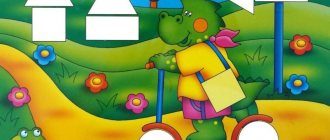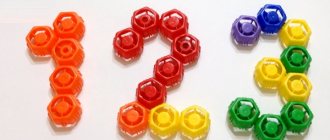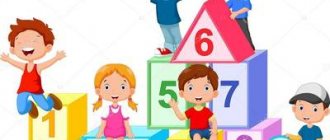Card index of didactic games and exercises to reinforce the concept of form
Didactic games and exercises
to reinforce the concept of form
“Find an item of the specified shape”
The child is asked to name models of geometric shapes, and then find pictures depicting objects similar in shape to a circle (square, oval, triangle, rectangle, rhombus).
“What figures does the machine consist of?”
Children must determine from the drawing what geometric shapes are included in the design of the machine, how many squares, circles, etc. it contains.
"Rug"
The child is asked to examine a rug made of geometric shapes and a set of components of this rug. Among the elements of this set, you should find the part that is not in the rug.
“Find an object of the same shape”
Children identify shapes in specific objects in the environment,
using geometric patterns. There are geometric shapes on one table, objects on the other. For example, a circle and round-shaped objects (ball, plate, button, etc.), an oval and oval-shaped objects (egg, cucumber, acorn, etc.).
“Which figure is the odd one out?”
The child is offered various sets of four geometric shapes.
For example: three quadrangles and one triangle, three ovals and one circle, etc.
It is required to identify the extra figure, explain the principle of exclusion and the principle of grouping.
Options:
- group real objects according to their shape according to 2-3 samples, explain the principle of grouping.
"Make a whole from parts"
Make a design of 2-3 geometric shapes according to the model.
Options:
⎯ make a design from memory, according to description;
⎯ create a geometric figure by selecting the necessary parts from the many proposed parts (8-9).
"Define correctly"
The child is asked to use the drawings to determine which geometric shapes the castle consists of.
"Visual dictation"
Children remember a pattern of 3-4 geometric shapes and put it together from memory.
Options:
⎯ children remember and reproduce combinations of figures (including three-dimensional geometric figures).
“Determine the shape of the object”
Cards with images of objects are laid out in front of the child: a TV, a house, a table, a chandelier, a floor lamp, a bed, etc. The teacher suggests using the appropriate slot on a punched card with cut out geometric shapes to select furniture whose image is similar to this geometric shape.
“Guess the geometric figure by touch”
Buttons in the shape of geometric shapes are sewn onto colored cardboard.
For each card, a cover is sewn into which it is easy to insert and remove the card. The cover should not be transparent.
Children's age: 3-7 years.
Goals and objectives:
Develop fine motor skills of the hands.
Learn to recognize and name geometric shapes: 2 junior and middle groups – circle, square, triangle; senior and preparatory school groups - circle, triangle, quadrangle, rectangle, polygon.
The child must determine by touch which figure is in the case, then take it out and check it. As new figures are learned, figures are added.
“It rolls - it doesn’t roll”
Purpose of the game: to introduce three-dimensional geometric bodies - a cube, a ball, and a cylinder for older children.
Equipment: cubes and balls, cylinders of different sizes and colors.
Progress of the game: show the children a ball, then a cube, accompanying the actions with the words: “This is a ball, it rolls - like this. The balls are smooth. Touch it. And this is a cube. Can the cube roll? No, he can not. But it has corners, touch them.” Do the same with the cylinder. Give the children one cube and one ball each and invite them to play with them: put them on the floor, on the table, on top of each other, roll them, etc. Then ask them to put the objects in boxes: balls in one box, cubes in another, cylinders in a third .
"The Figures Play Hide and Seek"
Purpose of the game: to introduce three-dimensional geometric bodies - a cube and a ball and teach them to select the necessary shapes.
Equipment: medium-sized cardboard box (1 - 2 pcs.) with square and round slots; cubes and balls of the same size and shapes: square, circle, triangle, rectangle, Magic chest of drawers with slots for shapes.
How to play: Show the children the box and teach them to push the balls into the slots - first the balls, then the cubes. Then offer to play hide and seek: “The toys decided to play hide and seek. Let's help them hide in a box." Give the children blocks and balls and ask them to take turns pushing them into the corresponding shaped holes in the box. This game can be repeated many times. Children push shapes of squares, triangles, etc. into the magic chest of drawers through the slots. Then the chest of drawers opens and everyone checks together whether the children have correctly placed the figures in the houses.
The teacher shows a figure, and the child says what a shape such a figure can be (for example, a cap is triangular; a refrigerator is rectangular; a ball is round, etc.)
“Find an object of the same shape”
Goal: to teach children to identify the shape of specific environmental objects using geometric patterns. Children learn for the first time to compare the shape of objects with geometric figures.
Material. Geometric shapes (circle, square, oval, triangle, rectangle), round-shaped objects (balls, spheres, buttons), square (building material, scarf, lotto cards), triangular (building material, flag, carrots), oval (egg, cucumber, whale toy).
Progress of the game: Geometric shapes lie on one table, objects on the other. The teacher asks the children to come to the table (they stand around the table), draws attention to various objects lying on the table, and explains the task. First he shows a figure and invites one child to name its shape, then find an object of the same shape on another table and put it next to it. If the child correctly finds the object and places it near the corresponding figure, all children clap their hands. In one lesson, each child can choose no more than three forms. If he is mistaken, then the teacher asks the child to circle the figure and object with his finger. This technique helps the child complete the task correctly.
"Find out the figure"
Purpose of the game: improve the perception of shape, develop voluntary attention, speed of movements.
Material: cards with images of geometric shapes - square, triangle, circle or objects similar to these shapes - wheel, pyramid, modules.
Progress of the game: The teacher introduces the children to the prepared geometric shapes, which he places in different parts of the room, and explains the rules of the game. At a signal, children move randomly around the hall, performing various movements. After the teacher names one of the figures, for example “Square”, the children should quickly build around this figure.
"Wonderful bag"
Purpose of the game: To train children to determine what kind of object it is by its characteristic external features, that is, by its shape.
How to play: To play, you will need a fabric bag made of thick, opaque fabric, into which objects of different shapes and textures are placed. I suggest identifying each item by touch without looking into the bag. You can also hide geometric shapes in it, the child must guess by touch which shape is hidden.
"Who will collect the pieces first"
Didactic tasks: consolidating knowledge of geometric shapes, developing an understanding of specific instructions, developing concentration, general and fine motor skills.
Equipment: geometric shapes scattered on the carpet (circles, squares, triangles, rectangles, ovals).
Progress of the game. The teacher gives each of the players cards with a figure that he must collect.
The child who quickly and without mistakes collects his pieces wins.
“What does it look like?”
Didactic tasks: consolidate knowledge of geometric figures, develop observation and thinking.
Progress of the game. Ball game. Children stand in a circle. The leader is in the center of the circle. The host throws the ball to the player and asks a question.
Listen guys
What will we play?
I'll ask questions now
And someone will answer!
1. The sun in the sky, what figure does it resemble? (circle)
2. What does the window look like? (square)
3. When you build a house, what figure do you put in place of a roof? (triangle)
4. If you approach the door, what figure do you remember? (rectangle)
5. When you take the ball, what shape do you remember? (ball)
6. What does a spyglass look like? (cylinder)
7. Without which figure it is impossible to build a house from a construction set? (cube)
Any object surrounding a child has a shape, so there can be a lot of questions.
Rules: You must answer by throwing the ball to the teacher.
Options: 1. Questions can be asked in reverse order: what does a square, circle, rectangle, triangle, ball, cube, cylinder look like?
2. The driver can be a teacher or a child.
Game “Which piece is the extra piece”
The child is offered several strips, for example:
on the 1st: 4 large round buttons and 1 small round button;
on the 2nd: 3 red figures and 1 green;
on the 3rd: 2 squares and 1 triangle.
The teacher asks:
—Which figure is superfluous here? Why?
Strips with signs of differences in shape and size are used. For example:
on the 1st:
on the 2nd: etc.
Game "Let's build a fence"
The game can be played outside near the sandbox. A set of geometric shapes meets the program requirements for each age group.
Goals
: clarifying knowledge about geometric figures and shapes of objects. Exercises in distinguishing figures and shapes of objects. Exercises in distinguishing shapes (circle, square, triangle), shapes of objects (round, square, triangular) and naming them correctly. Development of logical thinking.
Equipment:
sandbox, molds of different colors according to the number of children, scoops according to the number of children.
Progress of the game
The teacher gathers the children near the sandbox and shows them the already familiar molds. At the teacher’s suggestion, children tell what color the molds are and what shape they are (round, square, triangular). The teacher invites the children to build a fence of Easter cakes around the sandbox, alternating the Easter cakes in this way: round, square, triangular, round, etc. You can remind children how to make Easter cakes correctly so that they don’t fall apart. The children build the fence together and decorate it with natural materials in bulk.
Games "Magic figures"
The game can be played during a walk near the sandbox or in the experimentation corner in a group room.
Target:
clarifying ideas about geometric shapes
Equipment:
sandbox or container with fine sand, sheets of paper according to the number of children, glue stick.
Progress of the game
The teacher invites the children to a sandbox or container with sand. He gives the children sheets of paper and quickly draws geometric shapes on them with a glue stick (in accordance with the program requirements for each age group). Then the teacher invites the children to place the sheets on the ground or on tables and cover them with a layer of sand, and then carefully lift the sheets and shake off the sand from them into a sandbox or container. Together with the children, the teacher is surprised that geometric shapes have appeared on the sheets. At the teacher’s suggestion, the children tell what shapes each of them has.
To complicate the game, you can draw not figures, but various images from geometric shapes, for example, a house from a square and a triangle or a snowman from three circles of different sizes. Then the children tell what kind of images appeared on their sheets, what figures they consist of.
Once the images are dry, you can use them to develop your sense of touch. Then, at the teacher’s suggestion, the children close their eyes, and the teacher places a sheet with a “sand” figure in front of each of them. Children feel the pictures, name them, and then open their eyes and check the correctness of their answer.
Boards "Seguin"
An educational game - a puzzle for children "SEGUIN'S Boards", in meaning reminiscent of the methods of the famous teacher Edouard Seguin and the early development methods of Maria Montessori. The set contains 9 tablets - playing fields, each of which has 8 “boards” with empty squares, ovals, circles, rectangles, diamonds, triangles in the middle. The game is intended for children over 3 years old, but can also be played by adults.
The game is complicated by different patterns - the figurine must be inserted, taking into account the color, design, and ornament.
Classes with Seguin boards develop attention (search for figures of the same color), memory, color perception, promote the study of geometric shapes (square, circle, triangle, rectangle, rhombus, oval), stimulate the development of imaginative thinking (put together a whole pattern, ornament, drawing from parts ).
Collection of didactic games
"Cars"
There are long and short strips of the same width on the table
The teacher invites the children to take one strip each. These are the “numbers” of the cars. And the gates are garages. Let the guys imagine that they are all “cars”, each with their own “number”. "Cars" will drive around the city. But as soon as the presenter says: “Cars, go to the garage!” - everyone must find their own garage and move into it. To do this, you need to attach the “number” of your car to the “number” on the gate. If the “numbers” are the same in length, you can move in.
During the game “Cars”, show the children an illustration. Ask them questions to help them make sense of what is happening.
The game is repeated 2 times.
"Merry dolls"
Purpose of the game: to teach to distinguish and compare objects according to different qualities of quantities.
Equipment: 2 sets of five-seater nesting dolls, 2 sets of circles of different sizes, a tower made of hollow cubes.
Progress of the game: At the invitation of the teacher, the children sit at a common table on which there is a nesting doll. The teacher turns to the children: “I want to play funny nesting dolls with you, but I see that there is only one nesting doll here, but where are the rest? (looks around, and then picks up a matryoshka doll and shakes it). Something is rattling in the middle! Let's see what's there? (Removes the upper half of the matryoshka doll). This turns out to be where they hid! (All nesting dolls are placed in a row). Let's get to know them! The teacher calls the name of each doll, tilting it: “I am Matryosha, I am Natasha, I am Dasha, I am Masha,” etc. Each child chooses one of the nesting dolls (the teacher takes one matryoshka for himself). The game begins. First, the nesting dolls walk (walk on the table). Then they are called to measure height. They line up one after another and take turns, starting with the smallest one, standing according to height, and the teacher clarifies which nesting doll is the smallest (tallest)? Then the nesting dolls go to dinner. The teacher puts on the table a set of circles (plates) of five sizes, calls the children in turn, who select plates of the appropriate size for their nesting dolls. After lunch, the nesting dolls get ready for a walk. The teacher puts the second set of nesting dolls on the table, and the children select girlfriends of the same height for their nesting dolls. Pairs of nesting dolls move around the table. Then they run away and mingle. (“The nesting dolls wanted to run”). Unnoticed by the children, the teacher removes a pair of nesting dolls of the same height from the table. "Time to go home! - says the teacher. Get into pairs." The nesting dolls are lined up in pairs, and suddenly it turns out that a certain pair of nesting dolls is missing. The teacher invites the children to call the nesting dolls by name (if they remember). Everyone asks her to come back in unison. The nesting dolls appear, the kids put them in place and the toys go home. The teacher places on the table a tower made of hollow cubes (one side is missing) - these are houses for nesting dolls. At the request of the teacher, each child finds a home for his nesting doll. The nesting dolls bow, say goodbye and go home.




